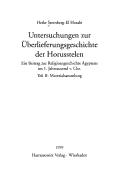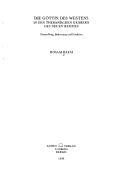| Listing 1 - 3 of 3 |
Sort by
|

ISBN: 3447041323 9783447041324 Year: 1999 Volume: 62 Publisher: Wiesbaden: Harrassowitz,
Abstract | Keywords | Export | Availability | Bookmark
 Loading...
Loading...Choose an application
- Reference Manager
- EndNote
- RefWorks (Direct export to RefWorks)
Horus (Divinité égyptienne) --- Horus (Egyptian deity) --- Horus (Egyptische godheid) --- Stele (Archaeology) --- Inscriptions, Hieroglyphic --- Stela (Archaeology) --- Stelae (Archaeology) --- Stelai (Archaeology) --- Steles (Archaeology) --- Archaeology --- Menhirs --- Hieroglyphic inscriptions --- Egypt --- Antiquities. --- Religion. --- Steles --- Religion --- Stele (Archaeology) - Egypt. --- Inscriptions, Hieroglyphic - Egypt. --- Horus (divinité égyptienne) --- Stèles --- Religion égyptienne --- Inscriptions égyptiennes --- Égypte --- Antiquité --- Histoire religieuse --- Jusqu'à 332 av. J.-C. --- 332 av. J.-C.-640

ISBN: 3980373029 9783980373029 Year: 1996 Volume: 12 Publisher: Berlin: Achet,
Abstract | Keywords | Export | Availability | Bookmark
 Loading...
Loading...Choose an application
- Reference Manager
- EndNote
- RefWorks (Direct export to RefWorks)
Inscriptions, Egyptian --- Goddesses, Egyptian --- Tombs --- Inscriptions égyptiennes --- Déesses égyptiennes --- Tombes --- Egypt --- Egypte --- Religion --- Goddesses, Egyptian. --- Goddesses --- Inscriptions, Egyptian. --- Inscriptions, Hieroglyphic --- Names. --- Inscriptions égyptiennes --- Déesses égyptiennes --- Goddesses - Names. --- Inscriptions, Hieroglyphic - Egypt - Thebes (Extinct city) --- Tombs - Egypt - Thebes (Extinct city) --- Thèbes (ville ancienne) --- Égypte
Book
ISSN: 15662055 ISBN: 9789004170308 9004170308 9786612399848 1282399845 9047442571 9789047442578 9781282399846 6612399848 Year: 2009 Volume: 33 Publisher: Leiden Boston Brill
Abstract | Keywords | Export | Availability | Bookmark
 Loading...
Loading...Choose an application
- Reference Manager
- EndNote
- RefWorks (Direct export to RefWorks)
This volume covers, for the first time, the interaction of a major historical event with the development of the Egyptian Solar-Osirian theology. Pharaoh Ramesses II visited the sacred area of Abydos soon after his recognition of power at Luxor in Thebes. With him were many high officials, one of whom would be soon appointed to be the high Priest of Amun at Thebes, Nebwenenef. During his visit, the king stressed his personal relationship with his father, Seti I as well as ordering the completion of his temple. By analyzing certain passages within Ramesses’ official acccount, the Dedicatory Inscription, with others of Seti, a more nuanced appreciation of the growing theological system of Osirus plus Re, the sun god, comes to the fore. This significance of this is heightened when we remember that the king's account was exhibited in the portico of Seti I’s temple. 'Anthony Spalinger’s new monograph discusses the Great Dedicatory Inscription and these processes anew by means of perspicuous, accurate, translations of the surviving texts, enlivened by equally stimulating commentaries. These are accompanied likewise by meticulously researched footnotes, which have been marshaled with a diligence for which the author is rightly renowned...All of this is done here with exemplary skill and a fine eye for detail, and our libraries are far the richer for it.' A.J. Peden
Ramses --- Inscriptions, Hieroglyphic --- Hieroglyphic inscriptions --- Rameses --- Osymandyas, --- Ramesses --- Ramessu --- Ramses, --- Ramesse --- Egypt --- Religion. --- Religion --- Osymandyas --- Inscriptions, Hieroglyphic - Egypt - Abydos (Extinct city) --- Ramses - II, - King of Egypt --- Egypt - Religion --- Ramsès (1301-1235-av.-J.-C.) --- Inscriptions égyptiennes --- Religion égyptienne --- pharaon --- Égypte --- Abydos (Égypte ; ville ancienne)
| Listing 1 - 3 of 3 |
Sort by
|

 Search
Search Feedback
Feedback About UniCat
About UniCat  Help
Help News
News